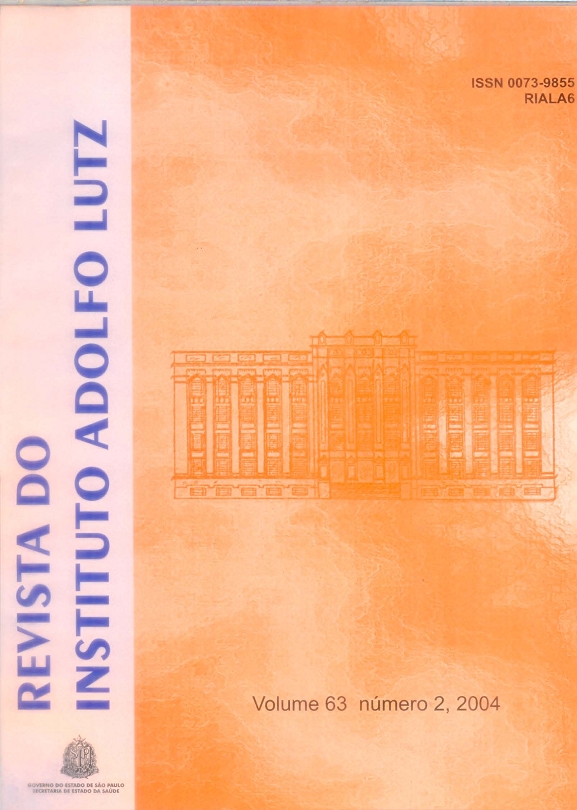Resumo
Mundialmente, as salmoneloses são consideradas um grande problema de saúde pública. Escherichia coli O157:H7 é outro importante patógeno devido ao aumento da incidência de doenças em humanos e sua associação com vários tipos de alimentos, principalmente os de origem animal. Foi determinada a incidência de Salmonella spp. e E. coli O157:H7 em 253 amostras de carnes cruas (bovina, suína e de frango) comercializadas em São Paulo, Brasil. Vinte e três amostras (9,1%) foram positivas para Salmonella spp. Entre estas 11 diferentes sorovares foram identificados e S. Enteritidis foi o mais prevalente. Todas as amostras foram negativas para E. coli O157:H7. A sobrevivência de S. Enteritidis (o sorovar predominante) e E. coli O157:H7 foi avaliada em carne bovina moída mantida sob refrigeração (4ºC) por 120 horas e congelamento (-18ºC) por até 90 dias de armazenamento. E. coli O157:H7 foi mais sensível que a S. Enteritidis nas temperaturas de refrigeração e congelamento, mas os dois patógenos se mantiveram viáveis até 90 dias de estocagem sob congelamento.
Referências
1. Ajjarapu, S.; Shelef, L.A. Fate of pGFP-Bearing Escherichia coli O157:H7 in Ground Beef at 2 and 10ºC and Effects of Lactate, Diacetate, and Citrate. Appl. Environ. Microbiol. 65(12): 5394-7, 1999.
2. Bean, N.H. et al. Surveillance for foodborne disease outbreaks – United States, 1988-1992: review. J. Food Prot. 60:1265-86, 1997.
3. Besser, R.E. et al. An outbreaks of diarrhea and hemolytic uremic syndrome from Escherichia coli O157:H7 in fresh-pressed apple cider. J. Am. Med. Assoc. 269:2217-20,1993.
4. Bryan, F.L.; Doyle, M.P. Health risks and consequences of Salmonella and Campylobacter jejuni in raw poultry. J. Food Prot. 58: 326-44, 1995.
5. Center of Disease Control. Escherichia coli O157:H7 outbreak linked to commercially distributed dry cured salami Washington and California. 1994. MMWR. 44:157-60,1995.
6. Centro de Vigilância Epidemiológica / Secretaria de Estado da Saúde de São Paulo. ftp://ftp.cve.saude.gov.br/doctec/surto dta. Acess. in jan.23, 2002.
7. Centro de Vigilância Epidemiológica / Secretaria de Estado da Saúde de São Paulo. http://www.cve.saude.sp.gov.br/htm/hidrica/dta_estat.htm. Acess. in mar. 10, 2005.
8. Cerqueira, A.M.F. et al. High occurrence of Shiga toxin-producing Escherichia coli (STEC) in healthy cattle in Rio de Janeiro State, Brazil. Vet. Microbiol. 70:11-21,1999.
9. Chiang, Y.H. Prevalence of Salmonella spp. in poultry broilers and shell eggs in Korea. J. Food Prot. 63:655-658, 2000.
10. Doyle, M.P.; Schoeni, M.P. Isolation of Escherichia coli O157:H7 from retail fresh meats and poultry. Appl. Environ. Microbiol. 53:2394-6,1987.
11. Fuzihara, T.O.; Fernandes, S.A.; Franco, B.D.G.M. Prevalence and dissemination of Salmonella serotypes along the slaugthering process in Brazilian small poultry slaughterhouses. J. Food Prot. 63:1749-53, 2000.
12. Griffin, P.M.; Tauxe, R.V. The epidemiology of infections caused by Escherichia coli O157:H7, other enterohemorrhagic E. coli, and the associated hemolytic uremic syndrome. Epidemiol. Rev. 13:60-98,1991
13. Hitchins, A.D.; Hartman, P.A.; Todd, E.C.D. Coliforms - Escherichia coli its toxins. In: Vanderzant, C.; Splittstroesser, D.F. (Eds), Compendium of methods for the microbiological examination of foods, 3rd. Washington, DC: APHA p.325-369, 1992.
14. ICMSF. Microorganisms in Foods, 1. Their significance and methods of Enumeration. 2nd ed. Intern. Comm. on Microbiolog. Spec. for Foods. Univ. of Toronto Press, Toronto, Ontario, Canada, 1988.
15. Irino, K. et al. O157:H7 shiga toxin-producing Escherichia coli strains associated with sporadic cases of diarrhea in São Paulo, Brazil. Emerging Infect. Dis. 8: 446-7, 2002.
16. ISO. Microbiology – General Guidance for the Detection of Salmonella. Intern. Org. for Standardization 6579, Geneva, Switzerland, 2002.
17. Jakabi, M. et al. Observações laboratoriais sobre surtos alimentares de Salmonella sp., ocorridos na Grande São Paulo, no período de 1994 a 1997. Rev. Inst. Adolfo Lutz, 1:47-51, 1999.
18. Jay, J.M. Modern Food Microbiology. 4th ed., Chapman & Hall, New York, p.314-34, 1992.
19. López, E.L. et al. Perspectives on Shiga-like toxin infection in Argentina. J. Food Prot. 60:1458-1462,1997.
20. Machado, J.; Bernardo, F. Prevalence of Salmonella in chicken carcasses in Portugal. J. Appl. Bacteriol. 69:477-80,1990
21. OPS. Almeida et al. (Eds), Contaminación microbiana de los alimentos vendidos en la vía pública. p.25-8,1996.
22. Paula, A.M.R. et al. Detection of Salmonella in foods using Tecra Salmonella Via and Tecra Salmonella Unique Rapid Immunoassays and a cultural procedure. J. Food Prot. 65:552-555, 2002.
23. Peeler, J.T.; Houghtby, G.A.; Rainosek, A.P. The most probable number tecnhique. In: Vanderzant, C.; Splittstroesser, D.F. (Eds.) Compendium of methods for the microbiological examination of foods, 3rd. Washington, D.C. APHA p. 105-120, 1992.
24. Peresi, J.T.M. et al. Surtos de enfermidades transmitidas por alimentos causados por Salmonella Enteritidis. Rev. Saúde Pública 32:477-83,1998.
25. Pessoa, G.V.A.; Silva, E.A.M. Meios de Rugai e lisina – motilidade combinados em um só tubo para a identificação de enterobactérias. Rev. Inst. Adolfo Lutz. São Paulo, 32:97-100, 1972.
26. Popoff, M.Y.; Le Minor, L. Formules antigéniques des sérovars de Salmonella. Centre Collaborateur OMS de Référence et de Recherche pour les Salmonella, 1997, Institut Pasteur, Paris.
27. Saad, S.M.I.; Franco, B.D.G.M. Influence of raw meat natural background flora on growth of Escherichia coli O157:H7 in ground beef. Rev. Microbiol. 30: 272-7,1999.
28. Sage, J.R.; Inghan, S.C. Survival of Escherichia coli O157:H7 after freezing and thawing in ground beef patties. J. Food Prot. 61:1181-3,1998.
29. Silva, N. et al. Ocorrência de Escherichia coli O157:H7 em produtos cárneos e sensibilidade dos métodos de detecção. Ciênc. Tecnol. Aliment. 21(2):223-7, 2001.
30. Silveira, N.F.A. et al. Occurrence of Escherichia coli O157:H7 in hamburgers produced in Brazil. J. Food Prot, 62:1333-5,1999.
31. Tavechio, A.T. et al. Changing patterns of Salmonella serovars increase Salmonella Enteritidis in São Paulo, Brazil. Rev. Inst. Med. Trop. 38:315-22,1996.
32. Teagasc, J.J.S. The effect of freezing on the survival of pathogens in different meat types and effect of varying lean fat ratios. Hygiene review, The Irish Society of Food Hygiene Technology, 1997.
33. Varnam, A.H.; Evans, M.G. Foodborne Pathogens. St. Louis: Mosby Year Book, London: Wolfe, 1991.

Este trabalho está licenciado sob uma licença Creative Commons Attribution 4.0 International License.
Copyright (c) 2004 Miyoko Jakabi, Dilma Scala Gelli, Christiane Asturiano Ristori, Ana Maria Ramalho De Paula, Harumi Sakuma, Giselle Ibette S Lopes, Sueli A. Fernandes, Renata B. Luchesi
